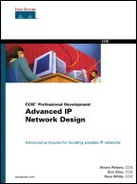Chapter 7. EIGRP Network Design
The previous two chapters looked at implementing two different link-state protocols, Open Shortest Path First (OSPF) and Intermediate System-to-Intermediate System (IS-IS). These are on the network in Figure 7-1, which was originally presented in Chapter 4, "Applying the Principles of Network Design," as Figure 4-10. This chapter follows suit by taking a look at implementing Cisco's advanced distance vector protocol—Enhanced Interior Gateway Routing Protocol (EIGRP).
For more information on how EIGRP functions, refer to Appendix C, "EIGRP Fundamentals." EIGRP has numerous advantages over its link-state counterparts, but it also has limitations and behaviors that a network designer must understand to successfully implement a scalable EIGRP network. This chapter describes some of these behaviors and provides techniques that network designers can use to improve the performance and scalability of EIGRP networks.
This chapter helps you to do the following:
Analyze summarization at the core, distribution layer, and access layer of an EIGRP network
Analyze the best way to deal with external connections, common services, and dial-in clients
Explore case studies on summarization methods, query propagation, excessive redundancy, troubleshooting common problems, and redistribution issues
